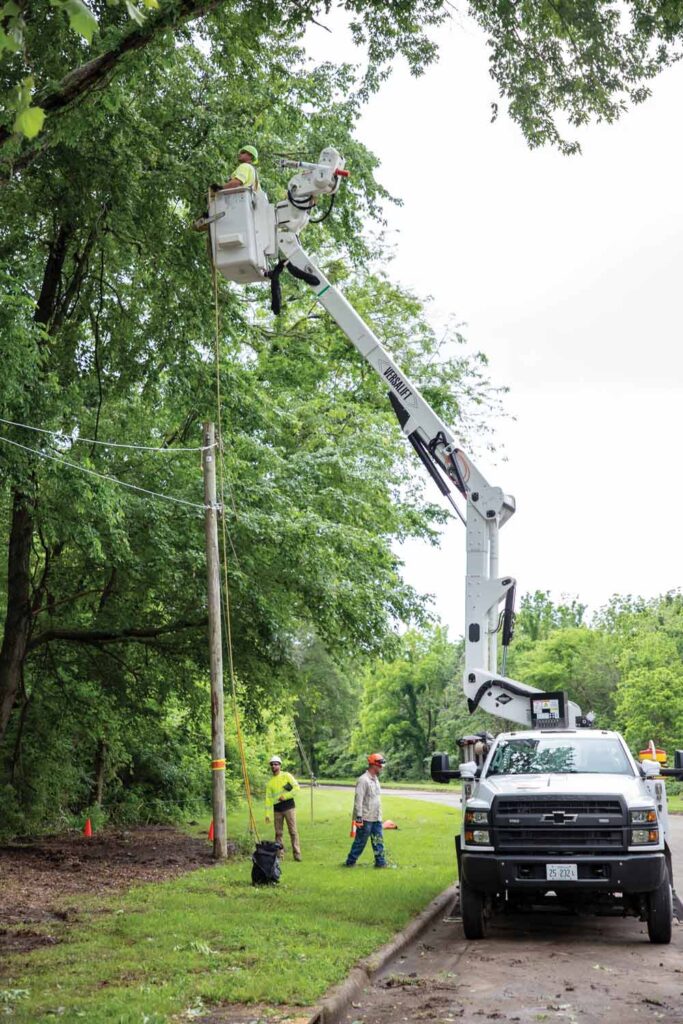With a shout and final buzz of a chainsaw, a tree crashes to the forest floor. Men in hardhats look to the instructor to learn more about tree felling techniques. These men are participating in a weeklong series of courses, held this year April 13-17 at Rend Lake in southern Illinois, to enhance their knowledge of line clearance.
The development of the line clearance training program in Illinois represents a significant advancement in worker safety and public service. Enhancing safety, improving power reliability and fostering professional growth, this program represents the importance of specialized training and the positive impact of electric cooperative efforts within the industry.

Putting down roots
In the late 1990s, Illinois’ electric cooperatives recognized a critical gap in employee training programs. While lineworkers had access to extensive apprenticeship and training opportunities, those working in line clearance did not. This discrepancy posed safety and reliability issues for both workers and the public. This led to what is now known as Utility Line Clearance School (ULCS).
“Safety. That’s the key element to everything that we’re trying to provide,” says Jim Miles, vice president of training, safety and loss control at the Association of Illinois Electric Cooperatives (AIEC).
“When you’re up in a tree near power lines, you’re in a hazard zone, and you have to be very careful and work to the safest measure you can to keep yourself protected,” Miles continues. “When the school was developed, it was the first time within our state cooperative program that anything of its kind was offered.”
The primary goal of this series of courses is to enhance the safety of line clearance workers. Given that these individuals often work in hazardous conditions near power lines, comprehensive training is essential. The program also aims to improve the reliability of power systems by ensuring proper tree maintenance and clearance, which prevents power outages caused by fallen trees or branches.
Miles credits the development of improved line clearance education to Cal Williams, who worked for 40 years at Corn Belt Energy Corporation as the manager of forestry and safety. Williams’ passion for the safety and professional growth of line clearance workers sparked the creation of a specialized educational program.
“He really had a sincere passion for those out there doing the work on the line clearance side of the business and wanted to pursue ways to help those workers grow in their careers,” Miles says.
Initially, the program’s curriculum focused on fundamental arboricultural skills, such as tree biology, proper pruning methods and climbing techniques. It also touched on electrical hazard awareness, essential for anyone working near power lines.
One of the earliest students of the program was Miles himself, who at the time worked in line clearance at Wayne-White Counties Electric Cooperative. “In 2002, I had the opportunity to participate as a student, marking my first exposure to formal training in line clearance,” Miles says.
Coming from a contractor background with predominantly on-the-job training, this program was lifechanging for Miles. On one hand, it offered structured, safety-focused education, unlike the informal training he previously experienced, that potentially saved his life. On the other hand, it led him down the road to help educate his peers when he was invited to become a ULCS instructor in 2004. Then, in 2008, Miles joined the AIEC’s safety department and inherited the school.
This allowed him to advocate for additional crucial training components and to further develop the program. The enhanced curriculum went on to include detailed instruction on electrical hazards, herbicide techniques, and advanced techniques for felling trees and removing limbs near power lines.
“We’ve created learning modules that represent real-life scenarios,” Miles explains, regarding the hands-on format of ULCS. “We try to make them as real as possible, even to the point that we build mock power lines. They just don’t have an energy source.”
These scenarios include ways to handle storm damage, emphasizing the safe removal of trees and branches from downed power lines. This allows students to gain hands-on experience in a controlled environment.
Branching out
 ULCS has grown significantly since its inception. Initially, about 15-20 students participated; today, the school has grown to well over 100 students annually. When educators and industry sponsors are added, the total number of participants reaches more than 200. This growth can be attributed to the program’s expanded scope and the inclusion of lineworkers in the training.
ULCS has grown significantly since its inception. Initially, about 15-20 students participated; today, the school has grown to well over 100 students annually. When educators and industry sponsors are added, the total number of participants reaches more than 200. This growth can be attributed to the program’s expanded scope and the inclusion of lineworkers in the training.
Recognizing that lineworkers can encounter tree-related hazards during outage calls, Miles says a shorter, intensive course specifically for them was introduced. He hopes that this integration will foster a mutual understanding and respect between lineworkers and line clearance workers, enhancing teamwork and safety.
The program’s success has extended beyond Illinois, with participants traveling from other states, including Ohio, Indiana, Kentucky and Arkansas. Some states have even adopted similar programs inspired by the ULCS curriculum.
According to Miles, one of the keys to the success of ULCS is its strategic location at Rend Lake in southern Illinois. The location allows for easy access to the interstate, especially for those traveling from neighboring states.
In addition, the AIEC collaborates closely with the Rend Lake Conservancy District. Areas of clearance are identified, and any trees trimmed or removed are either unhealthy, invasive or hazardous, which helps to improve public safety.
“Since we’ve moved to Rend Lake, I can’t ask for anything more,” Miles says. “The last thing we want to do is to go in and cut down healthy trees. At the end of the day, we’ve got a major respect for the aesthetics and the health of the trees, and there’s no point in going and taking down a bunch of trees, especially when they don’t need it.”
Public safety
Addressing public concerns about tree trimming and removal can be a delicate part of the job, Miles explains. Many homeowners become upset when their trees are pruned or removed for safety reasons. However, these actions are necessary to prevent accidents and ensure a reliable power supply.
“We’ve got to maintain a level of safety,” Miles says. “In a worst-case scenario, what if a child were to climb a tree and be able to reach a power line? Imagine how awful the outcome would be.”
Miles suggests that planting trees at a safe distance from power lines can help mitigate these issues in the future. Research before planting and determine how tall the tree will become and how wide the treetop will reach. If there’s a chance it could reach power lines at full growth, choose another location to plant the tree.
“Line clearance work is a job that has its hazards, but it is necessary to help ensure the safety of the public and to make sure that power is reliable,” Miles says.









